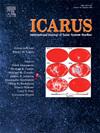火卫一模拟物的分光光度法2。孔隙率和质地的影响
IF 3
2区 物理与天体物理
Q2 ASTRONOMY & ASTROPHYSICS
引用次数: 0
摘要
表面孔隙率和织构是小体的重要性能。一些小行星和彗星可以在第一毫米层中表现出极高的表面孔隙度。这一层可以通过各种工艺产生,并通过缺乏大气来维持。然而,孔隙度对小体表面光谱光度特性的影响尚不完全清楚。在这项研究中,我们研究了纹理对火卫一风化层光谱模拟物的分光光度特性的影响。通过将模拟物与超纯水混合,产生冰尘颗粒,然后升华水,形成宏观和微观孔隙。水冰的升华使多孔和粗糙的粉末模拟物具有显著的微观和宏观孔隙度与宏观粗糙度相关。在可见光和近红外波段(0.5 ~ 4.2 μm)的反射光谱特性表明,多孔样品比致密样品更亮。一种模拟物在孔隙度增加后表现出光谱斜率变蓝,这可能与可膨胀层状硅酸盐的存在有关。在中红外范围内,由于硅酸盐的存在,发射率相关平台的对比度增加了10 μm。这种光谱特征通常在一些小行星上以10 μm的发射率平台观测到,这使得中红外区域对于评估矿物和表面纹理非常重要。光度法揭示了两种模拟物的致密粉末和升华残留物之间的相变红行为的改变。然而,在模拟物之间观察到的行为是不同的,这表明相变红可能取决于模拟物的组成。升华残留物的相曲线表现出较高的正向散射贡献。hake参数的推导表明,多孔样品的粗糙度增加,但反对效应没有明显的改变。在本实验中观察到的分光光度性质的变化肯定是由于升华后获得的结构变化,这取决于模拟物的初始组成。这项研究的目的是在即将到来的JAXA/火星卫星探测任务的背景下,通过使用两个火卫一模拟装置,为理解孔隙度提供新的见解。我们认为火卫一的蓝色单元可能是由于存在一个高度多孔的层,而不是像通常假设的那样仅仅是由于空间风化过程。本文章由计算机程序翻译,如有差异,请以英文原文为准。
Spectro-photometry of Phobos simulants II. Effects of porosity and texture
Surface porosity and texture has been found to be an important property for small bodies. Some asteroids and comets can exhibit an extremely high surface porosity in the first millimeter layer. This layer may be produced by various processes and maintained by the lack of an atmosphere. However, the influence of porosity on the spectro-photometric properties of small body surfaces is not yet fully understood.
In this study, we looked into the effect of the texture on the spectro-photometric properties of Phobos regolith spectroscopic simulants. Macro- and micro-porosity were created by mixing the simulants with ultra-pure water, producing ice-dust particles, and then sublimating the water. The sublimation of the water ice enabled the production of porous and rough powdered simulants with significant micro- and macro-porosity associated with macro-roughness. The reflectance spectroscopic properties in the visible and near-infrared (0.5–4.2 ) demonstrate a brightening of the porous samples in comparison to the compact ones. One simulant exhibits a bluing of the spectral slope after increasing porosity, which is likely linked to the presence of expandable phyllosilicates. In the mid-infrared range, a contrast increase of the 10 emissivity-related plateau due to silicates is observed. This spectral feature is typically observed as a 10 emissivity plateau on some asteroids, making the mid-infrared region important for assessing mineralogy and surface texture.
Photometry reveals a modification of the phase reddening behavior between the compact powder and the sublimation residue for both simulants. However, the observed behavior is different between the simulants, suggesting that the phase reddening may be dependent on the composition of the simulants. The phase curves of the sublimation residues exhibit a higher contribution of forward scattering. The derivation of the Hapke parameters indicates an increase in roughness for the porous sample, but no significant modification of the opposition effect. The modifications of the spectrophotometric properties observed in this experiment are definitely due to the textural changes obtained after sublimation, which depend on the initial composition of the simulants.
This study aims to provide new insights into the understanding of porosity by using two Phobos simulants in the context of the upcoming JAXA/Martian Moons eXploration mission. We suggest that the Phobos blue unit may be due to the presence of a highly porous layer, rather than only to space-weathering processes, as often postulated.
求助全文
通过发布文献求助,成功后即可免费获取论文全文。
去求助
来源期刊

Icarus
地学天文-天文与天体物理
CiteScore
6.30
自引率
18.80%
发文量
356
审稿时长
2-4 weeks
期刊介绍:
Icarus is devoted to the publication of original contributions in the field of Solar System studies. Manuscripts reporting the results of new research - observational, experimental, or theoretical - concerning the astronomy, geology, meteorology, physics, chemistry, biology, and other scientific aspects of our Solar System or extrasolar systems are welcome. The journal generally does not publish papers devoted exclusively to the Sun, the Earth, celestial mechanics, meteoritics, or astrophysics. Icarus does not publish papers that provide "improved" versions of Bode''s law, or other numerical relations, without a sound physical basis. Icarus does not publish meeting announcements or general notices. Reviews, historical papers, and manuscripts describing spacecraft instrumentation may be considered, but only with prior approval of the editor. An entire issue of the journal is occasionally devoted to a single subject, usually arising from a conference on the same topic. The language of publication is English. American or British usage is accepted, but not a mixture of these.
 求助内容:
求助内容: 应助结果提醒方式:
应助结果提醒方式:


